How to Create a Summer Schedule That Actually Works for Your Kids and Family
We may earn a commission for purchases made using our links. Please see our disclosure to learn more.
When school ends and summer begins, something funny happens.
You imagine long, sunny days full of laughter, popsicles, and backyard adventures. But within a week, your kids are asking, “What are we doing today?” before you’ve even had your first sip of coffee. Suddenly, that carefree season feels more like chaos on repeat. If you’ve felt that way too, you’re definitely not the only one. Building a summer schedule that actually works—for your kids and for you—isn’t about perfection or Pinterest-level planning. It’s about creating a rhythm that helps your family thrive, without losing the joy that makes summer magical.
This guide will help you design a simple, flexible, and heart-centered schedule you’ll actually stick with.
Why Structure Still Matters (Even on Lazy Summer Days)
Let’s be honest—most of us dream of a “go-with-the-flow” summer. But kids, even the spontaneous ones, crave a little predictability. Structure gives them security. They know what’s coming next, and that helps them relax and enjoy the moment.
Experts in child development agree that predictable routines lower stress and improve cooperation. They also save parents from decision overload—the constant “what now?” that drains your energy faster than the midday heat.
But remember: your summer routine doesn’t have to be rigid. Think of it as a gentle rhythm instead of a strict timetable.
Start with the Big Picture
Before you open a planner or print a calendar, pause and ask yourself:
What do I want this summer to feel like for our family?
Maybe you want slower mornings and more outdoor time. Maybe it’s about screen-free afternoons, or more moments where everyone sits down for dinner together.
Then, talk with your kids. Ask what they’d love to do—backyard camping? baking day? art Fridays? When they help shape the plan, they’re more likely to follow it.

Build Your Days Around Natural Anchors
Every family already has “anchors”—those dependable moments that happen daily, like breakfast, naps, or bedtime. Use those to shape your summer rhythm.
Here’s an example flow you can adapt:
- Morning: breakfast, outdoor play, or errands
- Midday: quiet reading, rest, or screen time
- Afternoon: crafts, swimming, or a playdate
- Evening: dinner, walk, bedtime routine
Keeping these anchors consistent gives your kids structure while allowing flexibility in between. You don’t need to schedule every minute—just enough to give the day a steady beat.
The Power of a Shared Family Calendar
One of the simplest sanity-savers for any parent? A shared family calendar. It’s the invisible backbone that holds summer together — keeping everyone’s plans, chores, and adventures in one easy-to-see place.
Start with something visual. Hang a big monthly calendar on the fridge, pinboard, or kitchen wall — somewhere everyone passes by at least once a day. Then, assign each person a color: blue for family fun, green for chores, pink for work hours, yellow for playdates or sports. When plans are color-coded, even little ones can recognize what’s happening next at a glance.
If your family lives on screens (let’s be honest, most of us do), digital tools like Google Calendar, Cozi, or FamCal can sync everyone’s devices. That way, you’ll get gentle reminders before soccer practice, dentist appointments, or that library craft day you nearly forgot.
Here’s the fun part — let your kids make it their own. Add stickers for birthdays, doodles for field trips, or emojis to mark family movie nights. When children participate in scheduling, they feel a sense of ownership and pride. Suddenly, the calendar isn’t “Mom’s job” — it’s everyone’s roadmap.
And here’s the magic: when your week lives out in the open, surprises drop dramatically. No more frantic “Wait, what are we doing today?” mornings or last-minute scrambles for swim gear. A few minutes of planning saves hours of stress — and helps your summer days flow with a little more calm and a lot less chaos.
Encourage Independence with Visual Tools
You don’t have to manage every move your kids make — in fact, teaching them to manage themselves is one of the greatest gifts you can give. That’s where visual tools come in. They show kids what’s next without you repeating it ten times a day.
Younger children thrive on picture-based routines because they translate time into something they can see. A photo of a toothbrush, pajamas, or a book tells them what comes next far better than words ever could. You can use magnetic boards, laminated cards, or printable charts that they can move, flip, or check off — a simple way to turn everyday tasks into small victories.
For older kids, a daily planner or checklist app can do wonders. It builds time awareness and personal accountability. Instead of nagging, you can just ask, “What’s next on your schedule?” and watch them take the lead. It’s not just about keeping them busy; it’s about helping them feel capable and trusted.
You can even turn it into a little family challenge — who can follow their chart all week? Maybe a reward like a special outing or extra storytime on Sunday night. The key is consistency, not perfection. With the right tools in place, your kids start running their own routines, and you finally get to breathe a little easier.

Recommended Amazon Products for Smoother Summer Scheduling
Here are five tried-and-tested Amazon picks that can make your summer schedule easier to follow—and more fun for your kids.
🧩 Visual Schedule for Kids Daily Routine Chart
This magnetic chart comes with 70 illustrated cards for tasks like brushing teeth, reading, or playtime. Kids move each card as they go—perfect for toddlers and preschoolers.
Why parents love it: It makes routines visible and rewarding.
Pros: Interactive, colorful, reusable.
Cons: May feel too young for school-age kids.
Use it for: Daily rhythm or morning/night routines.
🌈 Visual Schedule & Chore Chart – Responsibility Planner
A brilliant two-in-one system that helps kids manage chores and daily flow. It includes icons, reward slots, and customizable rows for each family member.
Why it works: Encourages accountability and teamwork.
Pros: Combines chores and schedule, fun design.
Cons: Takes consistency to maintain.
Use it for: Family tasks and routines.
🕒 Daily Schedule Organizer Stand
A freestanding mini-board that sits on a desk or shelf—kids can rearrange slots as they finish tasks.
Why parents like it: It’s tangible, compact, and gives kids ownership.
Pros: Easy to adjust, portable, visual.
Cons: May topple if handled roughly.
Use it for: Independent play or study time management.
📘 Scholastic Daily Planner
A simple yet effective dated planner designed for students. It helps older kids organize assignments, goals, or summer reading logs.
Why it’s great: Builds self-discipline and time awareness.
Pros: Structured layout, durable.
Cons: Works best for kids who enjoy writing.
Use it for: School prep, journaling, or goal tracking.
🗓️ Craft Weekly Planner Pad
This minimalist weekly pad is a parent favorite. It’s perfect for jotting meal plans, to-dos, and family activities.
Why it’s helpful: Keeps the grown-up schedule in sync with the kids’.
Pros: Affordable, clean design, easy to use.
Cons: No pictures for young children.
Use it for: Parent overview and planning.
Quick Comparison Table
| Product | Description | Pros | Cons | Best Use |
| Visual Schedule for Kids Chart | Magnetic picture-card board | Engaging, reusable | Too simple for older kids | Daily routines |
| Responsibility Planner Chart | Combines chores and routine tracking | Fun and motivating | Needs upkeep | Family coordination |
| Organizer Stand | Freestanding board with slots | Easy visual cue | May tip if bumped | Independent planning |
| Scholastic Daily Planner | Student-style dated planner | Builds discipline | Requires writing | Older kids’ planning |
| Craft Weekly Pad | Simple paper planner | Affordable and neat | No visuals | Parent scheduling |
Affiliate disclosure: As an Amazon Associate, I earn from qualifying purchases.
Blend Structure with Freedom
The best summer schedules leave room to breathe. Try following a “must-do, might-do, free-time” rhythm instead of rigid blocks.
- Must-do: meals, chores, reading time
- Might-do: crafts, park trips, baking
- Free time: creativity, rest, or spontaneous play
This simple framework helps everyone feel productive without pressure.
Make Downtime a Priority
Boredom isn’t the enemy—it’s often where imagination begins. Let kids explore unstructured play, and carve out your own rest moments, too. Maybe that’s 20 minutes of coffee and quiet while they build forts or draw.
Rest is part of a healthy schedule, not a luxury.
Encourage “Helper Energy”
Summer’s the perfect season to get kids involved in small responsibilities—watering plants, sorting laundry, helping with lunch. Turning chores into shared activities gives kids pride and lightens your load.
You can even create rotating “helper roles” each week. It’s teamwork disguised as life skills.
Keep Your Own Rhythm in Mind
Your energy drives the household rhythm. Whether you’re balancing remote work or home life, plan blocks for your needs too—work sprints, quiet coffee, or creative breaks.
A peaceful parent sets the tone for a peaceful home.
Stay Flexible
Even the best plans meet rainstorms, skipped naps, and surprise playdates. When that happens, remind yourself: flexibility is a strength, not a setback. Adjust, breathe, and carry on.
The magic of summer often hides in the moments you didn’t plan.
Keep Learning Light and Fun
Sneak learning into everyday fun—reading under a tree, counting seashells at the beach, or baking math into cookie recipes. These light-touch moments keep kids curious without making summer feel like school.

🧠 Research-Backed Insights: Why Routines and Brain Rhythms Matter
When you build a summer schedule, it’s not just about control or rules—it’s nurturing growth, safety, and mental resilience. The science supports that.
The American Academy of Pediatrics highlights how “regular, predictable family rhythms” help children feel secure and reduce behavioral stress. When kids know roughly what to expect—meals, rest, play—they stay calmer and more cooperative.
On the cognitive side, Harvard’s Center on the Developing Child explains that routines help strengthen executive function, the brain’s “air-traffic control” system. These skills let children plan, shift attention, resist impulses, and adapt to changes.
So yes: when you gently map out your summer days—without rigidity—you’re doing more than organizing time. You’re giving your kids tools for emotional stability and mental flexibility.
Common Parent Questions
How strict should our summer routine be?
Think rhythm, not rigidity. A loose framework works better than a strict clock.
How can I handle different ages and interests?
Keep shared anchor points (like meals and rest) and let each child choose their own “might-do” activities.
How can I manage my kids’ screen time in a balanced way?
Use it intentionally—after responsibilities or reading. Focus on creative or educational content when possible.
How can I juggle my job and family time without burning out?
Batch your focus periods during quiet times, and communicate boundaries clearly. Even small consistent blocks matter.
What if we fall off the schedule?
Reset tomorrow. One off day doesn’t mean failure—it means you’re human.
Helpful Resource
If you’re also preparing for a new baby or have loved ones expecting, check out these thoughtful gifts for expecting parents on Parentloom. It’s packed with meaningful, practical ideas that make early parenthood a little easier.
The Heart of It All
Creating a summer schedule isn’t about being perfect—it’s about being present. It’s about finding the rhythm that lets your family breathe, laugh, and connect.
You don’t need to fill every hour or orchestrate every activity. You just need a plan that supports balance, peace, and joy.
So here’s to a summer that feels lighter, calmer, and full of memories you’ll cherish long after the sunscreen fades. 🌞




